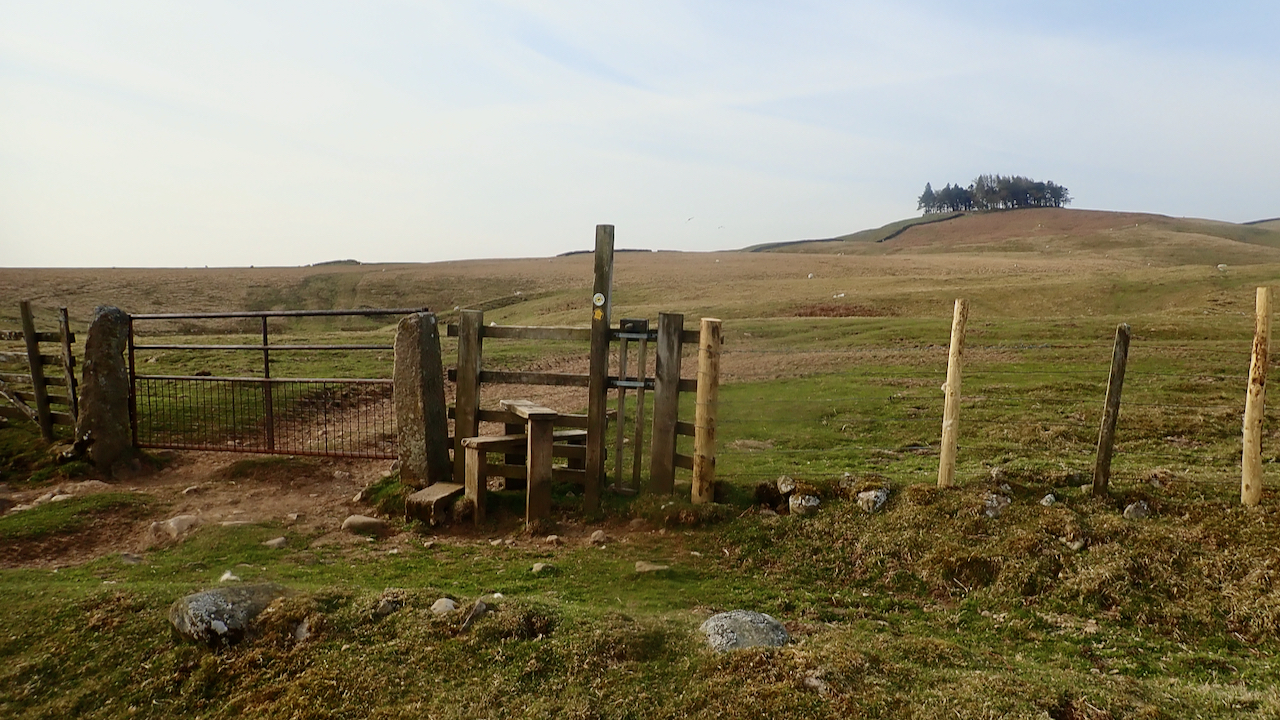I’ve never done the Pennine Way. All the way that is, in one go. I’ve done bits. Crossed it many times, but I’ve only ever been in the dales north of the A66, Baldersdale and Lunesdale, once before as I recall.
So I was quite looking forward for a run along the Pennine Way from Middleton-in-Teesdale to Baldersdale.
The climb out of Middleton is dominated by a distinctive copse of trees on the skyline. A brief glance at the map reveals it is a circular copse enclosed by a wall and named as Kirkcarrion. On the 1856 O.S. map it is named as ‘Kirk Arran’1“View Map: Yorkshire 4 (Includes: Hunderthwaite; Lunedale; Mickleton.) – Ordnance Survey Six-Inch England and Wales, 1842-1952.” Maps.nls.uk, 2021, maps.nls.uk/view/102344158#zoom=8&lat=8667&lon=10296&layers=BT. Accessed 20 Apr. 2021., a name which was also recorded as early as 17412“Currock – Yorkshire Historical Dictionary.” York.ac.uk, 2021, yorkshiredictionary.york.ac.uk/words/currock. Accessed 20 Apr. 2021..
The Pennine Way doesn’t actually go to it but veers off to the west, but I was intrigued and a little detour beckoned. There must be some history there.
It turns out the wall surrounds a bronze age burial mound which was found in the early 19th-century to contain a cist and funerary urn containing charred bones3sunbright57. “Kirkcarrion, Middleton-In-Teesdale, County Durham.” The Journal of Antiquities, The Journal Of Antiquities, 4 Aug. 2012, thejournalofantiquities.com/2012/08/04/kirkcarrion-middleton-in-teesdale-northumbria/. Accessed 20 Apr. 2021.. Apparently, a farm labourer removed some stones to build a wall and unearthed the cist, which comprised four flat stones standing on their edges topped with a fifth4Lloyd, Chris. “Kirkcarrion keeps its secrets still.” Northern Echo [Darlington, England], 8 Apr. 2016. Gale OneFile: News, link.gale.com/apps/doc/A526168668/STND?u=ed_itw&sid=STND&xid=51897265. Accessed 20 Apr. 2021.. The landowner, Lord Strathmore, promptly claimed the urn and put them on display in his castle5sunbright57. “Kirkcarrion, Middleton-In-Teesdale, County Durham.” The Journal of Antiquities, The Journal Of Antiquities, 4 Aug. 2012, thejournalofantiquities.com/2012/08/04/kirkcarrion-middleton-in-teesdale-northumbria/. Accessed 20 Apr. 2021..
Another excavation was carried out in 1849 but nothing further was found. Lord Strathmore had the wall built around the burial mound and pine trees planted as a mark of his respect for the ancient burial site6sunbright57. “Kirkcarrion, Middleton-In-Teesdale, County Durham.” The Journal of Antiquities, The Journal Of Antiquities, 4 Aug. 2012, thejournalofantiquities.com/2012/08/04/kirkcarrion-middleton-in-teesdale-northumbria/. Accessed 20 Apr. 2021..
Local legend says that Kirkcarrion is the burial site of Prince Caryn, a chieftain of the Brigantes. His ghost is said to haunt the site, a site where the wind never blows, whatever the inclemency of the weather7Wikipedia Contributors. “Kirkcarrion.” Wikipedia, Wikimedia Foundation, 29 Jan. 2021, en.wikipedia.org/wiki/Kirkcarrion. Accessed 20 Apr. 2021..
But, Prince Caryn may not wander Kirkcarrion alone. Apparently among the good folk of Teesdale and Lunedale, it has now become a popular place for the scattering of the ashes of their loved ones8Lloyd, Chris. “When a royal derriere rested on a stone in Willington.” Northern Echo [Darlington, England], 22 Apr. 2016. Gale OneFile: News, link.gale.com/apps/doc/A526792107/STND?u=ed_itw&sid=STND&xid=b13b5051. Accessed 20 Apr. 2021..
- 1“View Map: Yorkshire 4 (Includes: Hunderthwaite; Lunedale; Mickleton.) – Ordnance Survey Six-Inch England and Wales, 1842-1952.” Maps.nls.uk, 2021, maps.nls.uk/view/102344158#zoom=8&lat=8667&lon=10296&layers=BT. Accessed 20 Apr. 2021.
- 2“Currock – Yorkshire Historical Dictionary.” York.ac.uk, 2021, yorkshiredictionary.york.ac.uk/words/currock. Accessed 20 Apr. 2021.
- 3sunbright57. “Kirkcarrion, Middleton-In-Teesdale, County Durham.” The Journal of Antiquities, The Journal Of Antiquities, 4 Aug. 2012, thejournalofantiquities.com/2012/08/04/kirkcarrion-middleton-in-teesdale-northumbria/. Accessed 20 Apr. 2021.
- 4Lloyd, Chris. “Kirkcarrion keeps its secrets still.” Northern Echo [Darlington, England], 8 Apr. 2016. Gale OneFile: News, link.gale.com/apps/doc/A526168668/STND?u=ed_itw&sid=STND&xid=51897265. Accessed 20 Apr. 2021.
- 5sunbright57. “Kirkcarrion, Middleton-In-Teesdale, County Durham.” The Journal of Antiquities, The Journal Of Antiquities, 4 Aug. 2012, thejournalofantiquities.com/2012/08/04/kirkcarrion-middleton-in-teesdale-northumbria/. Accessed 20 Apr. 2021.
- 6sunbright57. “Kirkcarrion, Middleton-In-Teesdale, County Durham.” The Journal of Antiquities, The Journal Of Antiquities, 4 Aug. 2012, thejournalofantiquities.com/2012/08/04/kirkcarrion-middleton-in-teesdale-northumbria/. Accessed 20 Apr. 2021.
- 7Wikipedia Contributors. “Kirkcarrion.” Wikipedia, Wikimedia Foundation, 29 Jan. 2021, en.wikipedia.org/wiki/Kirkcarrion. Accessed 20 Apr. 2021.
- 8Lloyd, Chris. “When a royal derriere rested on a stone in Willington.” Northern Echo [Darlington, England], 22 Apr. 2016. Gale OneFile: News, link.gale.com/apps/doc/A526792107/STND?u=ed_itw&sid=STND&xid=b13b5051. Accessed 20 Apr. 2021.

Leave a Reply